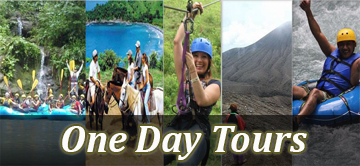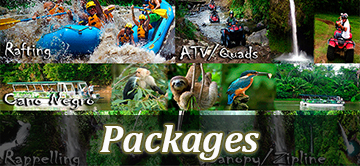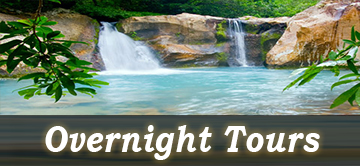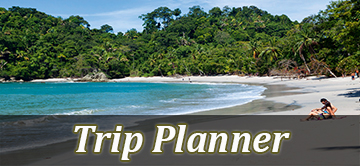ORIGIN AND GEOLOGIC CHARACTERISTICS OF COSTA RICA
Central America is characterized rather by the biodiversity that by the homogeneity, that is the predominant characteristic of this area because of the geographic situation. In addition it presents excellent characteristics, one double climate condition: the inter-oceanic and the inter-continental one.
Structurally the region extends from Mexico in the Isthmus of Tehuantepec, to the valley of Atrato in Colombia according to Dengo (1975). During this time the inter-oceanic channel of almost 3,000 kilometers separated North America from South America. For this one time, the Central America of the north was constituted by invasive and sedimentary rocks, because of the tectonic movements. At the end of this period and because of their movements it was actually formed, actually it is in the same form. When the Tertiary period finalized still exist a channel of approximately 300 km in length, which still separated the north of Nicaragua with the north of Colombia. In the south sector of Central America, during the Inferior Tertiary period and the Superior Cretaceous period, it appeared a chain of volcanic islands. In the Pliocene, three or four million years ago, the terrestrial bridge formed and consolidated. It separated the Pacific Ocean of the Atlantic Ocean and the North America with South America.
Thanks to the bridge condition, Central America allowed the animal and plant spreading as well as the migrations of human and the cultural interchange. The located mountainous systems in Guatemala, Honduras and in the north of Nicaragua, caused isolation, reason which the evolution of endemic species was favored and formed a barrier that prevented the diffusion. A clear example of this is the Pine tree which is not in the south of the Nicaraguan Lake.
To the south of Costa Rica is located the Mountain range of Talamanca, where we found oaks from North American mixed with origin South American coniferous. The combination of great variety of species from North America as well as from South America makes Central America, a privileged region for the wealth and the variety of flora and fauna, which is not found in any other part of the Western Hemisphere and which doesn’t has a territory of this same extension.
During the Freezing’s of the Pleistocene, the Straits of Bering was possibly frozen, which allowed the migrations from Asia to America. The first settlers, with a rudimentary culture were dedicating to the hunting, harvesting and fishing, extend all around the continent. Little by little they are going to develop two types of agriculture, one of them based on the tuber cultivation, like yucca, for the case of the Andean Region.
In the Mesoamerican area the crops were the corn and the beans. Thanks to this type of agriculture bloom three great civilizations in the American continent grew up: The Mayan, the Aztec in Mexico and Guatemala and the Inca in Peru.
GEOLOGIC HISTORY OF COSTA RICA
For more than 200 million years ago, began the geologic history of our country. For this period probably the continental masses were located in a position very similar to the actual.
As a product of separation of the American, European and African plate, as a result of the consequence of the cells action in convection with the magma. The Atlantic Ocean was created, whose origin must to with an extension zone, which covers from Iceland to the Antártida.
The Orogeny process (the process of mountain building and studied as a tectonic structural event) began with volcanic activities, accompanied by sprouting oceanic ridges and submarine crests. A result from this process is an archipelago oriented towards the east, and later on it would be known as the external arc, actually represented with a worn of series away from the mountain ranges, located in the Peninsula of Nicoya, Herradura Beach, Osa’s Peninsula and in Punta Burica.
An intense volcanic activity characterized this period and due to this, the erosion processes increased in the sedimentation of these areas. About sixty million years ago, during the Inferior and Average Eocene epoch(major division of the geologic timescale and the second epoch of the Paleocene period in the Cenozoic era.), almost disappeared the totality of the external arc, emerging lots of islands known as Guanarivas.
During Oligocene, 25 million years ago, these islands disappeared in the ocean and were covered by detritus material (death matter) as a consequence of the degradation and the later sedimentation.
Due to the intense volcanism it originated the Avocado Mountain and the mountain range of Talamanca. It starts an ascent and reaches the greater altitude of the internal arc. This volcanism would give later the origin to the Central Volcanic Mountain range and to the Mountain range of Guanacaste.
Thus, the conformation of the territory that Costa Rica occupies today has lasted approximately 8 to 10 million years, because the rise of the geologic structures occurs in a rate of 10 mm per year.
MAIN GEOLOGIC STRUCTURES OF COSTA RICA
The relief constitution is from the Northwest to the Southeast, with four mountainous chains: Guanacaste, Tilarán, Central Volcanic and Talamanca.
The Volcanic Mountain range of Guanacaste is formed by a row of volcanic cones. The Rincon de la Vieja and the Arenal volcano present volcanic activity. In the year 1968 the Arenal Volcano, started with a spectacular activity period, with lava emissions and ardent ash and clouds. In the south part of the Arenal Volcano was a small lake which they use to make a hydroelectric dam.
The Mountain range of Tilarán is constituted by volcanic rocks where gold seams have been found in some sectors like Abangares and Miramar.
The Central Volcanic Mountain range is formed by four volcanoes: Poás, Irazú, Barva and Turrialba. The Irazu volcano presented a great volcanic activity in the period between 1963 and 1965; at the moment it has some fumaroles, an area of thermal springs and gas vents with magma and hot igneous rocks
Poás Volcano has had volcanic activity in different moments as well as some ash eruptions. A phenomenon that is actually affecting its surroundings is the acid rain, which constantly burns the crops of vegetables, strawberries and many more.
Structurally the Mountain range of Talamanca is an anticline, usually recognized by a sequence of rock layers that are progressively older toward the center of the fold, formed by marine sediments and volcanic rocks.
It begins in the Central Valley and has a direction Northwest to Southeast.













